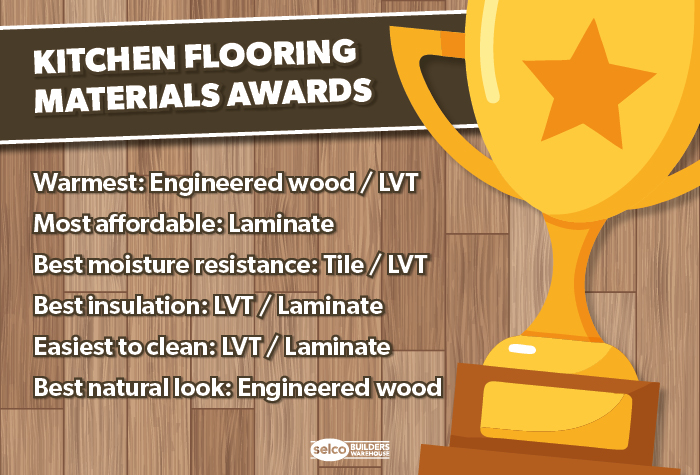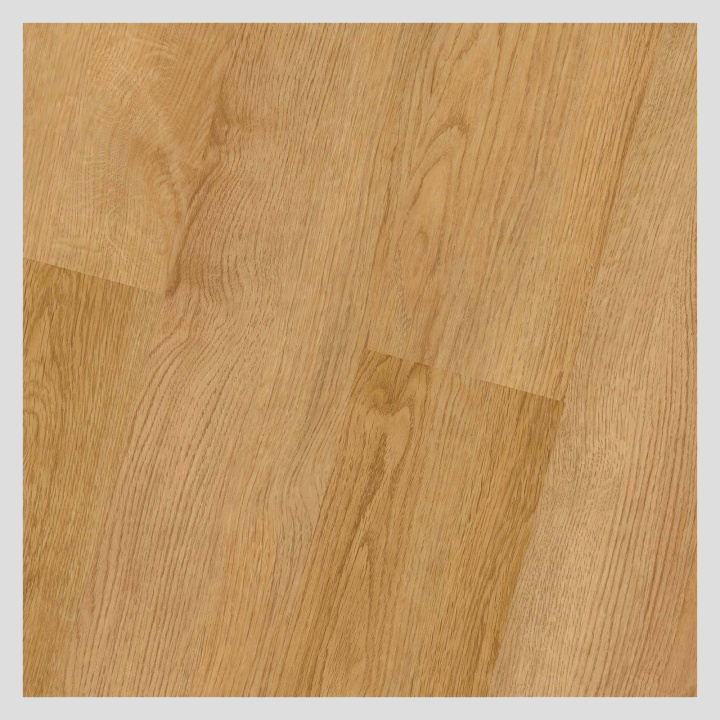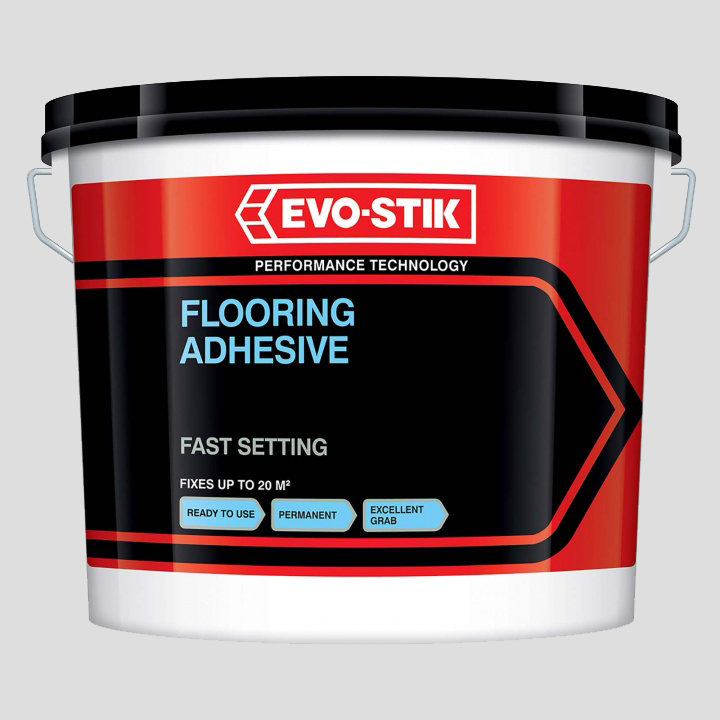The ultimate guide to choosing the perfect flooring for a kitchen
Homeowners will spend a lot of time looking for the perfect kitchen design for their home. Whether you’re helping to build a brand-new kitchen from scratch, or renovating an older one, the kitchen is one of the most important rooms in the home. Often the heart of a home, a kitchen is a semi-humid environment, where meals are whipped up and many appliances are run including ovens, hobs, microwaves, dishwashers, and sometimes washing machines and tumble dryers. When it comes to picking the best flooring for kitchen projects, you’ll need to consider foot traffic, food spillages, grease and moisture build-up, and of course, your customer’s budget, preference and style.
Your main flooring options for kitchens include wood, laminate, vinyl / LVT (luxury vinyl tile), and tiles, each with their own pros and cons. Overall, we’d recommend LVT flooring as one of the best kitchen floor coverings, as it has the best moisture resistance, scratch resistance and variety of styles, but we’ll talk through all the benefits of the different types of kitchen flooring available and the best flooring materials for kitchens in the UK throughout this blog.
Remember to check out our other kitchen blogs where we cover a range of handy topics such as how to choose the right kitchen tap and how to fit a flat-pack kitchen.
What features does kitchen flooring need to have?
Kitchen flooring needs to have a few key properties to make it suitable for the room. Most importantly, it needs to be water resistant – while the room won’t face as many moisture challenges as a bathroom or laundry room, the floor will inevitably be affected by steam, water and cooking spillages throughout its life cycle. The kitchen is also a high foot traffic area, often being the central hub for get-togethers alongside the living room, so the best kitchen flooring material will also be tough, durable and scratch-resistant, while being easy to clean when needed.

LVT flooring
Vinyl is an affordable, practical and durable option for kitchen flooring, and LVT (luxury vinyl tile) flooring is the best vinyl flooring for kitchens. LVT is a thicker, more crafted type of vinyl flooring that features a high-quality decorative layer mimicking natural materials like stone, ceramic, porcelain, wood or concrete. With LVT kitchen flooring you can achieve the appearance of a natural wood floor without the added expense, and with improved moisture and scratch resistance. Luxury vinyl flooring is also extremely easy to clean – spills and splashes are no match for the vinyl’s durable and water-resistant surface. LVT is warm and soft making it comfortable underfoot for daily use.
We stock a variety of LVT flooring in various stunning designs with natural colours and finishes. Most of our LVT flooring includes a quick and easy click locking system: the boards simply click together when laid making installation a breeze. If you’re looking for appealing, affordable and durable kitchen flooring, LVT flooring is an excellent choice.
Laminate flooring
Laminate flooring is another one of the most popular kitchen flooring options alongside LVT as it has a lot of similar qualities. With a high-quality decorative finish that perfectly mimics solid wood flooring and a durable protective layer to prevent stains and scratches, laminate kitchen flooring is a good choice for kitchens. Like LVT, laminate flooring has a surface that is very easy to clean which is perfect for a room like the kitchen where splashes and stains are inevitable. However, while laminate has a water-resistant top layer, it is not completely waterproof and if water does soak into the base layers this will damage the flooring, so make sure to clean up spillages quickly!
We stock a variety of the best laminate kitchen flooring options to choose from in a variety of gorgeous colours and textures. Many of our laminate flooring planks also have an easy installation system where the interlocking boards fit and click together with ease.
Tiling
Another popular choice for kitchen flooring is the use of ceramic, porcelain or natural stone tiles. Tiles are highly durable, waterproof and feature many classic, timeless designs. However, they’re hard and cold to walk on, and the grout used to connect them can stain easily and require regular cleaning if not sealed correctly. Grout, while moisture-proof, isn’t completely waterproof as it’s a porous material.
- Ceramic tiles have excellent water resistance and durability, are easy to clean down, and come in plenty of versatile and stylish designs. They’re affordable when compared to more expensive options like natural stone.
- Porcelain tiles are less porous than ceramic tiles, so they offer even better water resistance and durability. They’re less prone to chipping or cracking and are available in various appealing designs. This all makes them the best floor tiles for kitchens, but they can be difficult to install and are more expensive.
You can browse our floor tiles section for various porcelain and ceramic tiles in stunning colours, textures and patterns that can be suited to any traditional or modern kitchen designs.
Engineered wood flooring
The best wood flooring for kitchen projects is engineered wood flooring. Engineered wood has several qualities that make it a better choice over solid wood for kitchens, including its better tolerance for moisture and temperature changes. It will not expand or shrink as much as solid wood does and is often treated with preservative chemicals to improve the strength and durability of the wood while maintaining its natural features and beauty.
We have some engineered wood flooring available in natural designs, made from several layers of wood and a lacquered finish, with tongue and groove joints for a simple and easy interlocking installation process.

So, what's the best flooring for a kitchen?
All the above types of flooring can be used in a kitchen space, and each flooring material has its own features and benefits. After considering your customer’s budget, style and preferences, as well as the space you have available and the requirements of the room, you should be able to choose the ideal kitchen flooring for your customer’s kitchen.
If your customer is after warm kitchen flooring, engineered wood is a good option as it has good thermal insulation and is compatible with underfloor heating. Laminate and LVT flooring are also warm kitchen floor choices while being soft underfoot too.
If you’re looking for the best waterproof flooring for kitchens, LVT flooring is the superior choice. Porcelain tiles are another great option.
If it’s important to your customer to have flooring that’s easy to clean, LVT flooring and laminate are by far the easiest to maintain and clean with mops, cloths and vacuums. They also offer good stain resistance and water resistance so long as spillages are cleaned quickly.
If you’re working in a larger industrial or non-residential building, the best commercial kitchen flooring options for your project might differ from the above: if aesthetics aren’t an issue, rubber flooring is highly durable and moisture-resistant while absorbing sound and impact easily and is a great choice for areas where safety is essential.

What's the worst flooring for a kitchen?
Flooring materials that would not be recommended for a kitchen include solid wood and carpet.
A carpet is much more difficult to clean than a smooth surface such as laminate, so the unavoidable build-up of stains, spillages and moisture will ensure your carpet won’t last long in the kitchen.
Solid wood flooring is a possibility for the kitchen, but it’s not recommended – while it looks beautiful and natural, solid wood will expand/shrink in response to moisture levels and temperature. It can be treated and sealed, but it will need to be cleaned, maintained regularly and even refinished. For the natural wood design, engineered hardwood is the perfect option as it has a much better resistance and tolerance to temperature and moisture.
Get the supplies you need to get the job done

By Rae Davis
Rae is a Digital Copywriter within the Selco Team with 10 years' experience in the construction industry and specialises in long-form content writing. With a love for research and simplifying complicated information into easy-to-follow content, she is known for her handy how-to blogs. When she’s not at her desk, she’s got her head either in a book or up in the clouds.
< Back to Kitchens




